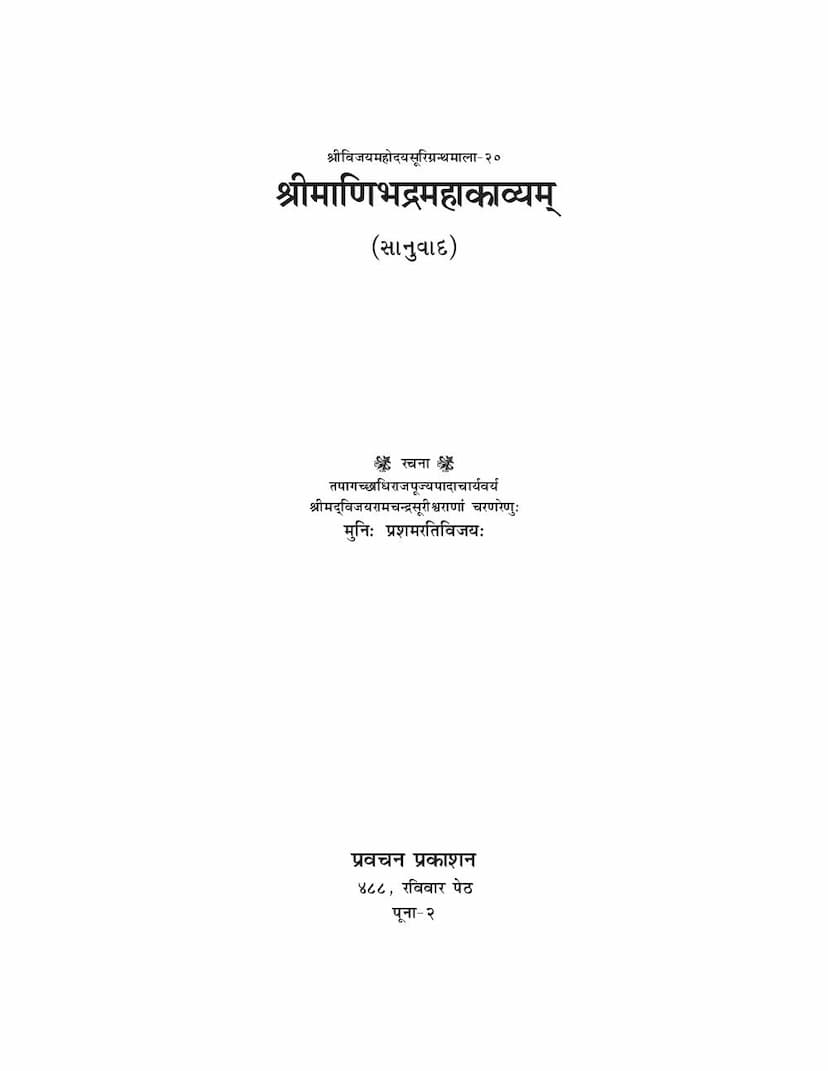Manibhadrakavyam
Added to library: September 2, 2025

Summary
Here's a comprehensive summary of the Jain text "Manibhadrakavyam" based on the provided pages:
Title: Sri Manibhadra Mahakavyam (with commentary) Author: Muni Prashamrativijay Publisher: Pravachan Prakashan, Pune Inaugural Edition: 2008
Overview:
"Sri Manibhadra Mahakavyam" is a significant work in Jain literature, composed in Sanskrit verse. It narrates the life story of Manibhadra, a Yaksha deity, and his past life as Manikyasingh Seth, a wealthy merchant from Ujjain. The work adheres to the classical conventions of Mahakavya (epic poetry) and is praised for its scholarly depth, poetic beauty, and devotional sentiment.
Key Themes and Content:
- The Life of Manikyasingh Seth: The narrative begins by detailing the opulent life of Manikyasingh Seth in the prosperous city of Ujjain. His physical beauty, virtuous character, generosity, and devotion to Jain principles are highlighted.
- Spiritual Conflict: Manikyasingh's life takes a turn when he encounters the teachings of Padmanabha Yati, who preaches against idol worship. This leads Manikyasingh to abandon his Jinvani (Jain worship). This causes distress to his devout mother and wife, who undertake vows of abstinence in protest.
- Realization and Repentance: Through the guidance of Guru Anandavimalasuri, Manikyasingh realizes his mistake and returns to the path of idol worship. He experiences profound repentance for his actions.
- Pilgrimage and Martyrdom: Inspired by his Guru, Manikyasingh decides to undertake a pilgrimage to the holy Mount Shatrunjaya. During his journey, he is tragically killed by dacoits in a forest.
- Rebirth as Manibhadra: After his death, Manikyasingh is reborn as Manibhadra, a powerful Yaksha deity, serving the Tapagachchha lineage.
- Divine Intervention: The text then shifts to a critical period for the Jain Shasan (Jain doctrine). Ten disciples of Guru Hemavimalasuri and Anandavimalasuri are killed by supernatural means due to the malicious actions of an antagonist named Padmanabha. The Gurus are in distress.
- Manibhadra's Role: The Yaksha Manibhadra appears before the distressed Gurus. He recounts his past life as Manikyasingh Seth and expresses his devotion. Upon learning about the plight of the Shasan, Manibhadra, with his immense power, defeats the malevolent forces and rescues the Gurus.
- Establishment of Manibhadra: The Gurus, recognizing Manibhadra's devotion and power, establish him as the presiding deity (Adhishthayak Dev) of the Tapagachchha.
- Poetic and Scholarly Excellence: The Mahakavya is lauded for its adherence to Sanskrit poetic conventions, including the use of various Chandas (meters), Alankaras (figures of speech), and Rasa (aesthetic sentiment). The commentary and introduction highlight the author Muni Prashamrativijay's mastery of Sanskrit and Jain philosophy. The author's ability to weave a compelling narrative from a historical account and imbue it with devotional essence is particularly praised.
- Philosophical Insights: The text touches upon philosophical concepts related to karma, the nature of devotion, the importance of virtuous conduct, and the ultimate goal of Moksha (liberation). The Gurus' discussions with Manikyasingh and their philosophical explanations on worship and conduct offer valuable insights.
Key Figures:
- Manikyasingh Seth: A wealthy merchant, the protagonist in his past life.
- Manibhadra: A Yaksha deity, Manikyasingh's rebirth, the presiding deity of the Tapagachchha.
- Guru Anandavimalasuri: The spiritual guide who influenced Manikyasingh.
- Guru Hemavimalasuri: Another revered Guru who faced adversity and received Manibhadra's help.
- Mother and Wife of Manikyasingh: Devout women who supported Manikyasingh's spiritual journey.
- Padmanabha Yati/Acharya: An antagonist who misguided Manikyasingh and later acted against the Jain Shasan.
Significance:
- This work is considered a pioneering effort in composing a Mahakavya in Sanskrit in the contemporary era, especially within the Jain tradition.
- It serves as an inspiration by showcasing the power of devotion, repentance, and the grace of divine beings in upholding Jain principles.
- The detailed descriptions of Ujjain, the forest, the battlefield, and the divine realm add to the richness of the epic.
Overall:
"Sri Manibhadra Mahakavyam" is a scholarly and devotional masterpiece that enriches Jain literature. It recounts a significant event in the history of the Tapagachchha, highlighting the virtues of faith, courage, and the ultimate triumph of righteousness. The author's skillful narration and profound understanding of classical literature make it a commendable addition to Jain studies.